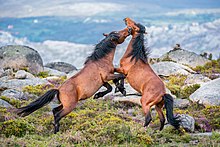Garrano
 Stallions fighting in Peneda-Gerês National Park | |
| Country of origin | Portugal |
|---|---|
The Garrano is a Portuguese breed of small horse. It is equivalent to the Faco Galego of Galicia in north-western Spain.[1]: 402
History[edit]

The horse is believed to be an ancient breed, with Northern Iberian Paleolithic cave paintings depicting horses with similar profiles.[1] The similarities between the breed and the depicted animals lead to the conclusion that the breed's appearance has remained stable.[citation needed] There is genetic evidence that the horse originates in Celtic regions, with additional research suggesting the later introduction of males for breeding from north Europe.[1] In the 20th century, the breed was infused with Arab blood.[citation needed]
The breed's numbers have been depleted by wolf predation, as they are a preferred prey. They have also declined as they have become less attractive for agricultural work, as a result of which they have been crossbred with other species for meat. As of 2010, the population of Garrano was estimated at approximately 2,000, with a sex ratio of one stallion to 13 mares.[1]
Characteristics[edit]

Members of the breed are usually bay, brown or dark chestnut in color, with a straight or concave facial profile, and stand on average 1.3 metres (12.3 hands; 51 in).[1] They are hardy and quick gaited breed and at one time were raced.[citation needed]
References[edit]
- ^ a b c d e José Vingada, Carlos Fonseca, Jorge Cancela, Joana Ferreira, Catarina Eira (2010). Ungulates and their management in Portugal. In: Marco Apollonio, Reidar Andersen, Rory Putman (editors) (2010). European Ungulates and Their Management in the 21st Century. Cambridge: Cambridge University Press. ISBN 9780521760614, pages 392–418.
Further reading[edit]
- Ruy d'Andrade (1938). Garranos. Boletim Pecuário. 6 (2): 281–292.
- J. Cañon, M.L. Checa, C. Carleos, J.L. Vega-Pla, M. Vallejo, S. Dunner (2000). The genetic structure of Spanish Celtic horse breeds inferred from microsatellite data. Animal Genetics. 31: 39–48.
- M.L. Checa, S. Dunner, J. Martin, J. Vega, J. Cañon (1998). A note on the characterization of a small Celtic pony breed. Journal of Animal Breeding and Genetics. 115 (1‐6): 157–163.
- J.C. Gomes, Maria do Mar Oom (2000). Caracterizção demográfica do núcleo de garranos bravios do PNPG. Revista Portuguesa de Zootecnia. 7 (1): 67–78.
- Cristina Luís, E. Gus Cothran, Maria do Mar Oom (2002). Microsatellites in Portuguese autochthonous horse breeds: Usefulness for parentage testing. Genetics and Molecular Biology. 25: 131–134.
- Cristina Luís, C. Coutinho, Joana Malta-Vacas, Joana Morais, Maria do Mar Oom (2000). Genetic diversity analysis of the three Portuguese native horse breeds inferred from microsatellite data. In 27th International Conference on Animal Genetics, 22–26 July, Food Animal Biotechnology Center, College of Veterinary Medicine, University of Minnesota.
- Maria do Mar Oom (1992). O cavalo Lusitano: Uma raça em recuperação (PhD thesis, in Portuguese). Lisbon: Department of Zoology and Anthropology, Faculty of Sciences, University of Lisbon.
- Maria do Mar Oom (2000). A genealogia do Garrano. In: Os Milenios do Garrano. Vieira do Minho: Associação dos Criadores de Equinos de Raça Garrana, pages 77–79.
- Maria do Mar Oom (2000). A genética molecular na produção cavalar em Portugal. In Jornadas de Equinicultura, 2 e 3 de Março, Vila Real, Portugal.
- Maria do Mar Oom, E. Gus Cothran (1996). Preliminary study of genetic variation of a feral pony from Portugal: The Garrano. Animal Genetics. 27 (Supplement 2): 17–42.
- M.C. Portas, J.M. Vieira-Leite (2000). Livro Genealógico dos Equinos de Raça Garrana. In: Second Congresso Ibérico sobre Recursos Genéticos Animais, 19 e 20 de Outubro, Estação Zootécnica Nacional, Santarém, Portugal.
- M.C. Portas, J.M. Vieira-Leite, J.J.D. Oliveira e Sousa (1998). A contribution to the study of Garrano horses = A raça Garrana. Um contribute para o seu estudo. Veterinária Técnica. 8 (6): 18–26.
- M.C. Portas, N. Vieira-e-Brito, I. Silva-Carvalho, J.M. Vieira-Leite (2001). La conservatión de la raza equina Garrana. Archivos de Zootecnia. 50: 171–179.
